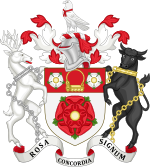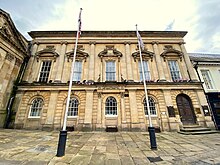
Northampton is a market town and civil parish in the East Midlands of England, situated on the River Nene, approximately 60 miles (97 km) north-west of London and 50 miles (80 km) south-east of Birmingham. It is the historic county town of Northamptonshire and the administrative centre of the unitary authority of West Northamptonshire. Northampton is one of the largest towns in England; the population of its urban area was recorded as 245,899 in the 2021 census.
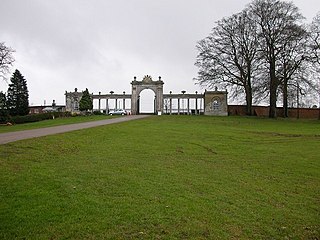
Northamptonshire is a ceremonial county in the East Midlands of England. It borders Leicestershire, Rutland, and Lincolnshire to the north, Cambridgeshire to the east, Bedfordshire, Buckinghamshire, Oxfordshire to the south, and Warwickshire to the west. The county town is Northampton.

Corby is a town and civil parish in the North Northamptonshire unitary authority area of Northamptonshire, England. It is located 23 miles (37 km) north-east of Northampton. From 1974 to 2021, the town served as the administrative headquarters of the Borough of Corby. At the 2011 Census, the built-up area had a population of 56,810, while the borough, which was abolished in 2021, had a population of 75,571 in 2021.

East Northamptonshire was a local government district in Northamptonshire, England, from 1974 to 2021. Its council was based in Thrapston and Rushden. Other towns included Oundle, Raunds, Irthlingborough and Higham Ferrers. The town of Rushden was by far the largest settlement in the district. The population of the district at the 2011 Census was 86,765.
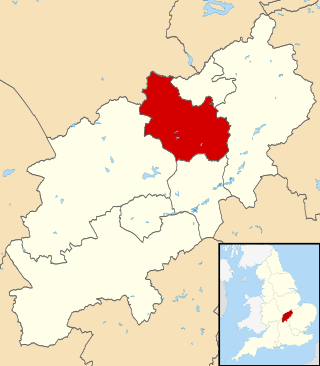
The Borough of Kettering was a local government district and borough in Northamptonshire, England, from 1974 to 2021. It was named after its main town, Kettering, where the council was based. It bordered onto the district of Harborough in the neighbouring county of Leicestershire, the borough of Corby, the district of East Northamptonshire, the district of Daventry and the borough of Wellingborough.
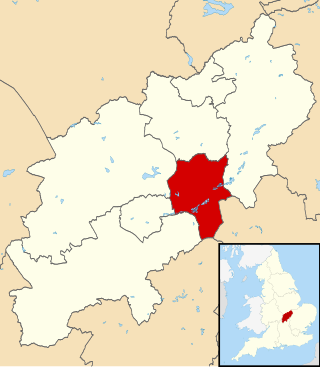
The Borough of Wellingborough was a non-metropolitan district and borough in Northamptonshire, England, from 1974 to 2021. It was named after Wellingborough, its main town, but also included surrounding rural areas.

Kent County Council is a county council that governs most of the county of Kent in England. It is the upper tier of elected local government, below which are 12 district councils, and around 300 town and parish councils. The county council has 81 elected councillors. The chief executive and chief officers are responsible for the day-to-day running of the council. Roger Gough is the leader of the council as of October 2019. Kent County Council is currently controlled by the Conservative Party with 61 seats. The Labour Party have 7 seats. It is one of the largest local authorities in England in terms of population served and the largest local authority of its type.

Somerset Council, known until 1 April 2023 as Somerset County Council, is the unitary authority which governs the district of Somerset, which occupies the southern part of the ceremonial county of the same name in the South West of England. The council has been controlled by the Liberal Democrats since the 2022 local elections, and its headquarters is County Hall in Taunton.

The unitary authorities of England are those local authorities which are responsible for the provision of all local government services within a district. They are constituted under the Local Government Act 1992, which amended the Local Government Act 1972 to allow the existence of counties that do not have multiple districts. They typically allow large towns to have separate local authorities from the less urbanised parts of their counties and originally provided a single authority for small counties where division into districts would be impractical. However, the UK government has more recently created much larger unitary authority areas, including a single authority for North Yorkshire, the largest non-metropolitan county in England, previously divided into seven districts.

East Hunsbury is a large residential area in the south of the town of Northampton, England, 3 miles (5 km) from the town centre and 1 mile (2 km) from junction 15 of the M1 motorway. For administrative purposes it is part of the unitary authority of West Northamptonshire. It is part of the Hunsbury residential area, which also includes West Hunsbury on the west side of Towcester Road. Shelfleys is the original name for the area of Northampton currently referred to as West Hunsbury. The name of West Hunsbury still appears on maps for the district as Shelfleys. Merefield is the corresponding name for East Hunsbury, together with the name "Blackymore" for the eastern part of East Hunsbury. All three names are still on local direction signs in Northampton, although older references are no longer in use by the local people living there. The areas developed in the 1980s and 1990s as part of the expansion of Northampton. The Northampton loop of the West Coast Main Line railway running between Northampton and London Euston runs under East and West Hunsbury via the Hunsbury Hill Tunnel emerging near Hill Farm Rise which follows the original course of Towcester Road prior to the 1980s. Ventilation shafts are visible in the housing estate in Yeoman Meadow. East Hunsbury was awarded ‘Best Large Village’ in 2019 by NorthantsAcre.

Kirklees Council is the local authority providing most local government services for the metropolitan borough of Kirklees in West Yorkshire, England. The council is one of five constituent members of the West Yorkshire Combined Authority.

North Northamptonshire is one of two local government districts in Northamptonshire, England. It is a unitary authority area forming about one half of the ceremonial county of Northamptonshire. It was created in 2021. Its notable towns are Kettering, Corby, Wellingborough, Rushden, Raunds, Desborough, Rothwell, Irthlingborough, Thrapston and Oundle. The council is based at the Corby Cube in Corby.

West Northamptonshire is a unitary authority area covering part of the ceremonial county of Northamptonshire, England, created in 2021. By far the largest settlement in West Northamptonshire is the county town of Northampton. Its other significant towns are Daventry, Brackley and Towcester; the rest of the area is predominantly agricultural villages though it has many lakes and small woodlands and is passed through by the West Coast Main Line and the M1 and M40 motorways, thus hosting a relatively high number of hospitality attractions as well as distribution centres as these are key English transport routes. Close to these is the leisure-use Grand Union Canal.

Norfolk County Council is the top-tier local government authority for Norfolk, England. Its headquarters are based in the city of Norwich.

Lambeth London Borough Council is the local authority for the London Borough of Lambeth in Greater London, England. It is a London borough council, and one of the 32 in the United Kingdom capital of London. The council meets at Lambeth Town Hall in Brixton. Lambeth is divided into 25 wards: thirteen are represented by 3 councillors and twelve are represented by 2. The council was first elected in 1964.

Lewisham London Borough Council is the local authority for the London Borough of Lewisham in Greater London, England. It is a London borough council, one of 32 in the United Kingdom capital of London. The council is unusual in that its executive function is controlled by a directly elected mayor of Lewisham, currently Damien Egan. Lewisham is divided into 19 wards, each electing two or three councillors. There are currently 16 three member wards and 3 two member wards. Following the May 2018 election, Lewisham London Borough Council comprises 54 Labour Party councillors. The council was created by the London Government Act 1963 and replaced two local authorities: Deptford Metropolitan Borough Council and Lewisham Metropolitan Borough Council.

The United Kingdom government austerity programme is a fiscal policy that was adopted for a period in the early 21st century following the Great Recession. The term was used by the Coalition and Conservative governments in office from 2010 to 2019, and again during the 2021–present cost of living crisis. The two periods are separated by a stint of interventionist, Keynesian spending during the COVID-19 pandemic.
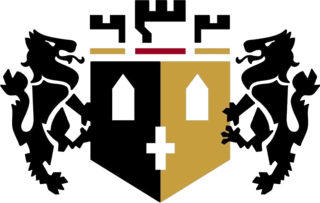
Northampton Borough Council was the borough council and non-metropolitan district responsible for local government in the large town of Northampton in England. In 2021 the council was abolished and succeeded by West Northamptonshire Council; a unitary authority, and the Northampton Town Council, a parish council.

Torbay Council is the local authority of Torbay in Devon, England. It is a unitary authority, having the powers of a non-metropolitan county and district council combined. It provides a full range of local government services including Council Tax billing, libraries, social services, processing planning applications, waste collection and disposal, and it is a local education authority. The council appoints members to Devon and Somerset Fire and Rescue Authority and the Devon and Cornwall Police and Crime Panel. Torbay is divided into 16 wards, electing 36 councillors. The whole council is elected every four years with the last election taking place on 2 May 2019 and the next election scheduled for 2023. The council was created by the Local Government Act 1972 and replaced the Torbay Borough Council of the County Borough of Torbay. Since 1974 Torbay has held borough status which entitles the council to be known as Torbay Borough Council, although it has not used this name since becoming a unitary authority. The council no longer has a directly elected mayor of Torbay; the post was abolished in 2019, after a referendum held in May 2016.

Andrew Iain Lewer is a British Conservative Party politician. Elected as the Member of Parliament for Northampton South in the 2017 general election, he previously served as Member of the European Parliament for the East Midlands from 2014 to 2017. He is the only person in the UK to have served as a Council Leader, MEP and MP.
